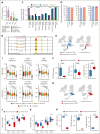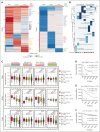Single-cell panleukemia signatures of HSPC-like blasts predict drug response and clinical outcome
- PMID: 40089994
- PMCID: PMC12163743
- DOI: 10.1182/blood.2024027270
Single-cell panleukemia signatures of HSPC-like blasts predict drug response and clinical outcome
Abstract
The critical role of leukemia-initiating cells as a therapy-resistant population in myeloid leukemia is well established. However, the molecular signatures of such cells in acute lymphoblastic leukemia remain underexplored. Moreover, their role in therapy response and patient prognosis is yet to be systematically investigated across various types of acute leukemia. We used single-cell multiomics to analyze diagnostic specimens from 96 pediatric patients with acute lymphoblastic, myeloid, and lineage-ambiguous leukemias. Through the integration of single-cell multiomics with extensive bulk RNA sequencing and clinical data sets, we uncovered a prevalent, chemotherapy-resistant subpopulation that resembles hematopoietic stem and progenitor cells (HSPC-like) and is associated with poor clinical outcomes across all subtypes investigated. We identified a core transcriptional regulatory network (TRN) in HSPC-like blasts that is combinatorially controlled by HOXA/AP1/CEBPA. This TRN signature can predict chemotherapy response and long-term clinical outcomes. We identified shared potential therapeutic targets against HSPC-like blasts, including FLT3, BCL2, and the PI3K pathway. Our study provides a framework for linking intratumoral heterogeneity with therapy response, patient outcomes, and the discovery of new therapeutic targets for pediatric acute leukemias.
© 2025 American Society of Hematology. Published by Elsevier Inc. Licensed under Creative Commons Attribution-NonCommercial-NoDerivatives 4.0 International (CC BY-NC-ND 4.0), permitting only noncommercial, nonderivative use with attribution. All other rights reserved.
Conflict of interest statement
Conflict-of-interest disclosure: D.T.T. received research funding from Beam Therapeutics and NeoImmuneTech; serves on advisory boards for Beam Therapeutics, Janssen, Servier, Sobi, and Jazz Pharmaceuticals; and has multiple patents pending on chimeric antigen receptor T-cell therapy. S.P.H. has received consulting fees from Novartis; has received honoraria from Jazz Pharmaceuticals and Servier; and owns common stock in Amgen. The remaining authors declare no competing financial interests.
Figures








Comment in
-
Getting to the root of high-risk leukemias.Blood. 2025 Jun 5;145(23):2673-2674. doi: 10.1182/blood.2025029069. Blood. 2025. PMID: 40471625 No abstract available.
References
-
- Dick JE. Acute myeloid leukemia stem cells. Ann N Y Acad Sci. 2005;1044(1):1–5. - PubMed
-
- Lapidot T, Sirard C, Vormoor J, et al. A cell initiating human acute myeloid leukaemia after transplantation into SCID mice. Nature. 1994;367(6464):645–648. - PubMed
-
- Bonnet D, Dick JE. Human acute myeloid leukemia is organized as a hierarchy that originates from a primitive hematopoietic cell. Nat Med. 1997;3(7):730–737. - PubMed
-
- Cobaleda C, Gutiérrez-Cianca N, Pérez-Losada J, et al. A primitive hematopoietic cell is the target for the leukemic transformation in human Philadelphia-positive acute lymphoblastic leukemia. Blood. 2000;95(3):1007–1013. - PubMed
MeSH terms
Grants and funding
- U24 CA196173/CA/NCI NIH HHS/United States
- K08 CA273531/CA/NCI NIH HHS/United States
- F30 CA268782/CA/NCI NIH HHS/United States
- K12 CA076931/CA/NCI NIH HHS/United States
- U10 CA180886/CA/NCI NIH HHS/United States
- T32 HD043021/HD/NICHD NIH HHS/United States
- U54 HL165442/HL/NHLBI NIH HHS/United States
- R01 CA193776/CA/NCI NIH HHS/United States
- R01 CA264837/CA/NCI NIH HHS/United States
- T32 GM007170/GM/NIGMS NIH HHS/United States
- R03 CA256550/CA/NCI NIH HHS/United States
- U24 CA114766/CA/NCI NIH HHS/United States
- F30 CA277965/CA/NCI NIH HHS/United States
- K08 CA286762/CA/NCI NIH HHS/United States
- U10 CA180899/CA/NCI NIH HHS/United States
- U2C CA233285/CA/NCI NIH HHS/United States
LinkOut - more resources
Full Text Sources
Medical
Miscellaneous

